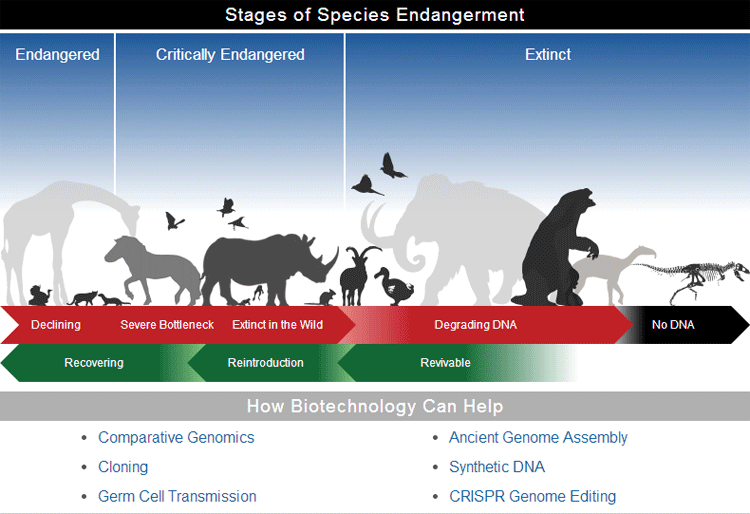In the age of technological advancement, where boundaries between the conceivable and the unimaginable are swiftly eroding, the concept of de-extinction emerges as a powerful, albeit contentious, topic. The term itself evokes images of long-lost creatures, resurrected from the annals of time, which raises profound ethical questions about the implications of reviving species that have traversed the path to extinction. At the crux of this discussion lies not only the scientific allure of bringing back ancient wonders but also the moral tapestry woven with threads of animal welfare and conservation ethics.
De-extinction can be characterized as the venture into the revival of extinct species through genetic manipulation and technological ingenuity. Scientists envision a future where animals like the woolly mammoth or the passenger pigeon might once again roam the Earth, an idea that captivates the imagination. These visions, however, illuminate a complex web of ethical dilemmas concerning animal cruelty, ecological equilibrium, and the responsibilities of humankind toward both the living and the extinct.
To understand the paradox of de-extinction, one must first explore the motivations driving this scientific endeavor. Proponents often argue that reviving extinct species could restore ecological balance disrupted by human activity. In this light, de-extinction becomes a salve for the wounds inflicted upon the biosphere, an act of redemption for humanity’s transgressions. Yet, this perspective does little to address the nuanced realities of such interventions. The question arises: do we possess the right to rekindle the sparks of life in beings that have perished, especially when their absence is a testament to the limitations of natural selection and the consequences of human interference?
When contemplating the revival of extinct species, one must navigate through the murky waters of ethical responsibility. The mere act of bringing back a species does not guarantee a flawless reintroduction into contemporary ecosystems. Imagine the woolly mammoth, lumbering through grasslands that have long since evolved into something unrecognizable. The ecological niches it once occupied may now be filled by other organisms, creating a potential struggle for survival. In this scenario, the revived animal might encounter not just a hostile environment but also profound psychological distress. What does it mean for an animal to exist in a world that has forgotten its kind?
The implications extend beyond ecological considerations. Reviving extinct species necessitates intervention at the genetic level, often involving techniques such as cloning or genome editing. Such procedures are riddled with ethical concerns regarding animal welfare. The process of manipulating genes carries the specter of unintended consequences. Are we prepared to witness the suffering that may arise from experimentation on creatures who do not ask for resurrection? Furthermore, the very act of cloning raises interrogative eyebrows—does it strip away the essence of what it means to be a species, transforming individuals into mere commodities of scientific ambition?
Moreover, the potential for animal cruelty escalates when the realities of captivity emerge. The revived creatures may find themselves ensnared in facilities designed for study and observation, stripped of their natural habitats. In these settings, they are vulnerable to exploitation, viewed as symbols of human ingenuity rather than sentient beings deserving of agency. The ethical implications of captivity loom large, juxtaposing the noble ambition of de-extinction against the stark reality of animal rights. From this perspective, the dream of reviving extinct species transforms into a troubling narrative, where the quest for knowledge blinds us to the suffering it may inflict.
Undoubtedly, the debate surrounding de-extinction ignites passionate discussions about the ethical treatment of animals, both extinct and extant. As stewards of the environment, humans are tasked with a profound responsibility: to protect the homes of living creatures and to acknowledge the scars left by our actions. The potential to bring back the dead might indeed appeal to the idealistic heart, but it also necessitates a sober reflection on the implications of such endeavors. We ought to examine whether reviving the deceased contributes to a fuller understanding of our role within the tapestry of life or merely serves as a distraction from the pressing need for conservation and the safeguarding of existing species.
The moral quandaries surrounding de-extinction can be likened to standing on the precipice of a cliff—peering down into the depths of uncertainty. Should we leap, driven by the thrill of change and experimentation, or do we remain grounded, taking measured steps to preserve the sanctity of the living world? Engaging with these questions forces us to confront our broader values surrounding nature and our relationship with animals. It compels us to envision a future where compassion reigns over curiosity, where the revival of species is rooted not in human desire, but in authentic ecological necessity.
As the dialogue on de-extinction unfolds, it is crucial to navigate this territory with empathy and foresight. While the dream of resurrecting ancient creatures can ignite a flame of hope, it is essential to temper this enthusiasm with a commitment to ethical integrity. Society stands at a crossroads, faced with the choice of either pursuing technological elegance at the cost of animal welfare or embracing our role as guardians of the natural world, ensuring that future generations inherit a planet rich with diversity and life in its many forms.








